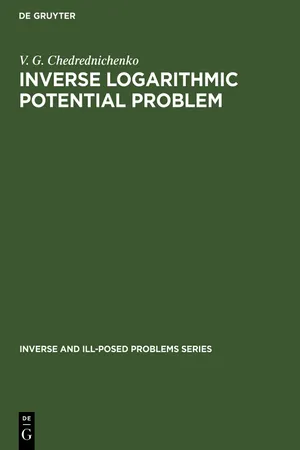
This is a test
- 250 pages
- English
- PDF
- Available on iOS & Android
eBook - PDF
Inverse Logarithmic Potential Problem
Book details
Table of contents
Citations
About This Book
The Inverse and Ill-Posed Problems Series is a series of monographs publishing postgraduate level information on inverse and ill-posed problems for an international readership of professional scientists and researchers. The series aims to publish works which involve both theory and applications in, e.g., physics, medicine, geophysics, acoustics, electrodynamics, tomography, and ecology.
Frequently asked questions
At the moment all of our mobile-responsive ePub books are available to download via the app. Most of our PDFs are also available to download and we're working on making the final remaining ones downloadable now. Learn more here.
Both plans give you full access to the library and all of Perlego’s features. The only differences are the price and subscription period: With the annual plan you’ll save around 30% compared to 12 months on the monthly plan.
We are an online textbook subscription service, where you can get access to an entire online library for less than the price of a single book per month. With over 1 million books across 1000+ topics, we’ve got you covered! Learn more here.
Look out for the read-aloud symbol on your next book to see if you can listen to it. The read-aloud tool reads text aloud for you, highlighting the text as it is being read. You can pause it, speed it up and slow it down. Learn more here.
Yes, you can access Inverse Logarithmic Potential Problem by V. G. Cherednichenko in PDF and/or ePUB format, as well as other popular books in Mathematics & Differential Equations. We have over one million books available in our catalogue for you to explore.
Information
Table of contents
- Introduction
- Chapter 1. Formulation of Inverse Logarithmic Potential Problem. Fundamental Equation
- §1.1 Formulation of inverse problem
- §1.2 Nonlinear boundary value problem for mapping function
- §1.3 The analytic continuation of the potential across a boundary
- §1.4 The boundary analyticity of domain is a solution to an inverse problem
- §1.5 The structure of inverse problem solution. final solvability. Examples
- Chapter 2. Local Solvability of an Inverse Problem
- §2.1 Univalent function variation
- §2.2 Local theorem of existence
- §2.3 Linearization of the boundary value problem
- §2.4 The auxiliary problem
- §2.5 The Newton-Kantorovitch method
- §2.6 The explicit solution of the linear problem
- §2.7 The local uniqueness theorem
- §2.8 The density variation. The equivalent solution set of the inverse problems. Remarks
- §2.9 The complex-valued density case
- §2.10 Existence theorems for the inverse problem for small constant densities
- §2.11 Proof of theorems
- Chapter 3. The Estimate of Bounded Univalent Function Coefficients and Univalent Polynomials
- §3.1 Classical estimates. Classes of bounded functions and with bounded image area
- §3.2 The estimate of univalent polynomials coefficients
- §3.3 The Diedonne-Horowitz inequalities for univalent polynomials
- §3.4 Numerical estimates of univalent polynomials coefficients
- Chapter 4. Mass Potential Estimates. Necessary Conditions for Solvability. A Priori Estimates for Inverse Problem Solution
- §4.1 Exact estimates for a mass potential gradient in the three-dimensional case. Extremal domain
- §4.2 Exact estimates of logarithmic mass potential
- §4.3 A priori estimates for inverse potential problem solution
- §4.4 On zeros of a potential mass gradient
- §4.5 Estimates of mass potential derivatives in a fixed angle
- §4.6 The estimates of the mass potential derivatives in the disk
- §4.7 The estimate of the mass potential based on the Calderon-Zygmund results for the singular integral
- §4.8 The necessary solvability conditions, a priori estimates — using the univalent function theory
- Chapter 5. The Continuation by the Parameter of an Inverse Problem Solution
- §5.1 The dependence of an inverse problem solution on the parameter - a constant density
- §5.2 The theorem on the continuation of a solution by the parameter
- §5.3 Inverse potential problems and univalent functions
- Chapter 6. On the Analyticity and Smoothness of an Inverse Problem Solution
- §6.1 Theorem on the smoothness of inverse problem solutions
- §6.2 Applications of the theorem on smoothness, in connection with free boundary smoothness
- §6.3 Analytical continuation of the potential through the angle points
- Chapter 7. Inverse Linear Problem. Determination of a Density of the Given Domain by its Exterior Potential
- §7.1 Existence theorems. The particular solutions of the inhomogeneous problem construction
- §7.2 Solution of the homogeneous problem. Density of the vanishing external potential
- §7.3 Special classes of domains
- §7.4 Determination of a body’s density by the given potential of an elliptic equation
- §7.5 Linear inverse problem in the classes Lp
- Chapter 8. Conjugation of Harmonic and Analytic Functions: Direct and Inverse Problems
- §8.1 Problems of the linear conjugation for harmonic and analytic functions
- §8.2 The particular cases, modifications, applications and generalization of the base conjugation problem
- §8.3 Formulation of inverse problems
- §8.4 Applied inverse problems
- §8.5 Interior inverse problems
- Chapter 9. Applications in Gravity Prospecting and in Magnetic Prospecting
- §9.1 Setting of problems. The algorithm for numerical construction of the equivalent solutions set by the analytically given field
- §9.2 On one approximation method (analytic continuation) for gravitational fields
- §9.3 Examples of the numerical constructing of the equivalent solutions family
- §9.4 Approximation of the anomaly field and determining the object by the random search method
- Bibliography